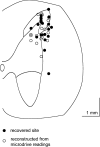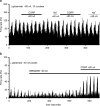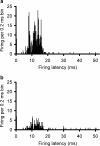Calcitonin gene-related peptide (CGRP) modulates nociceptive trigeminovascular transmission in the cat
- PMID: 15237097
- PMCID: PMC1575174
- DOI: 10.1038/sj.bjp.0705807
Calcitonin gene-related peptide (CGRP) modulates nociceptive trigeminovascular transmission in the cat
Abstract
Calcitonin gene-related peptide (CGRP) is released into the cranial circulation of humans during acute migraine. To determine whether CGRP is involved in neurotransmission in craniovascular nociceptive pathways, we microiontophoresed onto neurons in the trigeminocervical complex and intravenously administered the CGRP receptor antagonists alpha-CGRP-(8-37) and BIBN4096BS. Cats were anaesthetised with alpha-chloralose, and using halothane during surgical preparation. A craniotomy and C1/C2 laminectomy allowed access to the superior sagittal sinus (SSS) and recording site. Recordings of activity in the trigeminocervical complex evoked by electrical stimulation of the SSS were made. Multibarrelled micropipettes incorporating a recording electrode were used for microiontophoresis of test substances. Cells recorded received wide dynamic range (WDR) or nociceptive specific (NS) input from cutaneous receptive fields on the face or forepaws. Cell firing was increased to 25-30 Hz by microiontophoresis of L-glutamate (n = 43 cells). Microiontophoresis of alpha-CGRP excited seven of 17 tested neurons. BIBN4096BS inhibited the majority of units (26 of 38 cells) activated by l-glutamate, demonstrating a non-presynaptic site of action for CGRP. alpha-CGRP-(8-37) inhibited a similar proportion of units (five of nine cells). Intravenous BIBN4096BS resulted in a dose-dependent inhibition of trigeminocervical SSS-evoked activity (ED50 31 microg kg(-1)). The maximal effect observed within 30 min of administration. The data suggest that there are non-presynaptic CGRP receptors in the trigeminocervical complex that can be inhibited by CGRP receptor blockade and that a CGRP receptor antagonist would be effective in the acute treatment of migraine and cluster headache.
Copyright 2004 Nature Publishing Group
Figures







Comment in
-
Calcitonin gene-related peptide (CGRP) antagonists: blockers of neuronal transmission in migraine.Br J Pharmacol. 2004 Aug;142(7):1053-4. doi: 10.1038/sj.bjp.0705806. Epub 2004 Jul 5. Br J Pharmacol. 2004. PMID: 15237096 Free PMC article.
References
-
- ARMITAGE P, BERRY G. Statistical Methods in Medical Research 1994Oxford: Blackwell Science; 3rd edn
-
- BAHRA A., MATHARU M.S., BUCHEL C., FRACKOWIAK R.S.J., GOADSBY P.J. Brainstem activation specific to migraine headache. Lancet. 2001;357:1016–1017. - PubMed
-
- BEREITER D.A., BEREITER D.F., HATHAWAY C.B. The NMDA receptor antagonist MK-801 reduces Fos-like immunoreactivity in central trigeminal neurons and blocks select endocrine and autonomic responses to corneal stimulation in the rat. Pain. 1996;64:179–189. - PubMed
-
- BLOOM F.E. To spritz or not to spritz: the doubtful value of aimless iontophoresis. Life Sci. 1974;14:1819–1834. - PubMed
Publication types
MeSH terms
Substances
Grants and funding
LinkOut - more resources
Full Text Sources
Other Literature Sources
Research Materials
Miscellaneous

